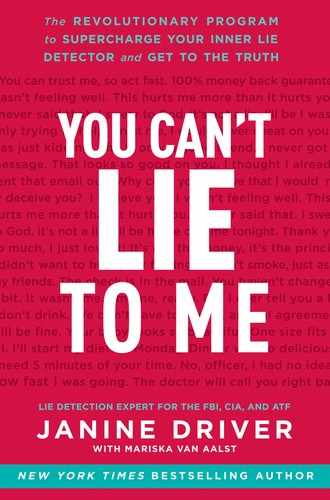7
STEP 4: THE FULL BODY SURVEILLANCE
Obviously we’re under constant surveillance, a camera on every phone, a camera in every home. Wake up people, it’s 2011.
—RAPPER BOBBY RAY
PEOPLE WITH THE BEST BS BAROMETERS are the ones who can quickly spot deviations from the baseline—like my friend Marti the private investigator, whom we first met in chapter 4.
Marti was hired by a trucking company to investigate who was at fault when a tractor-trailer full of iPods was stolen. The pair of drivers had been instructed that, before they turned in for the night, they were to back their truck up to an electrified fence in order to discourage anyone from swiping their pricey load. Sadly, the team had not backed up the truck, and sure enough, the next morning, the truck was cleaned out.
Marti went down to see them for a little chat. One of the two seemed a little too “savvy,” she says. She could tell he was lying by the fifth or sixth question she’d asked him. How could she tell? She started to notice these little hot spots on his left side—he’d hold the corner of his mouth down to create a crease, and he’d roll his left shoulder every time she’d ask him where he was from. Hmm, what was going on here?
He was honest about most other things: he’d immediately handed over his cell phone (which most crooks wouldn’t do) and he’d confessed to being too chicken to back up to the electric fence (which had allowed the thieves ready access). So why the crease about something as innocent as where he was born?
“Son,” Marti said kindly. “It’s going to be a whole lot easier for you to tell me now than for me to find out later.” He took a deep breath and put his head down and shook it from left to right, and confessed. “They never found out I got a criminal record for burglary,” he said. “And now they’re going to find out.” He hadn’t stolen the iPods—but he had lied to his employers originally on his job application, and those were the deceptive stressors Marti was seeing.
With the information you’ve gathered from the first three steps—the intel, the wiretap, and the stakeout—in hand, it’s time for your training in the rest of nonverbal communication: full body surveillance.
In this chapter, we’ll learn how to mine this amazing channel of communication that some experts say contains more than 50 percent of the true message behind our words. This info will give you instant power every time you go on a first date, secure a job interview, or apply for a mortgage—you’ll have access to knowledge that no one else knows because you’ll see the hidden subtext of those gestures and movements all around you. Your job in this chapter is simply to learn to note the hot spots—not to proclaim guilt or innocence. You have to reserve judgment until all the facts are in, until after you complete the next chapter, called “The Interrogation.” Let’s start with your own body language.
BE THE CHANGE YOU’RE LOOKING FOR
Bearing in mind that people tend to mirror one another, it’s in your best interest to present honest, open body language. This will serve two purposes:
- Using strong, open, honest body language will help any subject feel more secure with you.
- Because he’ll unconsciously feel like you trust him, he may be more open to telling you the truth.
Because, remember: we’re not looking for the lie; we’re looking for the truth. Anything you can do to help other people be honest will help you, too.
7-SECOND FIX
WITH THE CAR SALESMAN

(Baron Thrower II)
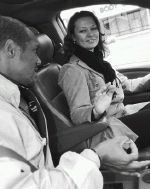
(Baron Thrower II)
The Problem: You get roped in quickly by a charismatic car salesman’s charm and at first you don’t pick up on the fact that his right foot is across his left leg, where he’s flashing you his “naughty bits,” but you soon catch on! You cannot afford to be taken advantage of, so you need to move quickly.
The Fix: Use this embedded command: “Listen to me [pause]. When you [pause and lower voice] do what I say and [pause] accept less, then we’ll close the deal.”
Once he pulls out the heavy artillery with that “A-Okay” emblem (which in this picture looks 100 percent super-sexual—and inappropriate), you can maximize your power when you take action fast and turn your body away from him, use a palm-down gesture, and get out of the car.
The Result: You are always in the driver’s seat!
When you consciously use open, honest, natural body language cues, people around you will subconsciously mirror them.
Honest people tend to:
- Point their toes and body toward you
- Lean forward with casual interest
- Be somewhat casual and at ease, but not artificially, so they shift their body posture fluently, without any nervous tics
- Keep their throat, neck dimple, belly button, and “naughty bits” all open and pointed toward you
- Use a wide, solid, powerful stance (“short fat candle”) versus a tight, wobbly stance (“tall skinny candle”)
- Uncross arms, keep their hands down at their sides or on their chairs
TAKING CARE OF BUSINESS IN FULL BODY SURVEILLANCE
By now, you must have the tightrope walker’s analogy frozen in your brain! So you probably are not surprised to know that our body’s nonverbals walk along that same tightrope, with the same three categories of signals to make your BS Barometer’s needle go crazy.
Now let’s consider what kinds of individual body signals you’ll see within each of these categories.
TEETER-TOTTERING
The biggest teeter-tottering red flag you might see during your full body surveillance will be obvious physical discomfort or unconscious incongruence of a liar’s gestures with what’s coming out of his or her mouth.
Ill-Timed Shoulder Shrugs
Shoulder shrugs indicate uncertainty, so when a shrug shows up with a definitive statement, it could indicate deception.
“Have you ever cheated on your husband?”
If you see “No!” partnered with a shoulder shrug, there’s definitely more to the story there. Although typically very subtle, and often involving only one side, the shoulder goes up around the ears. That shrug belies the “No”—there’s something being held back. But it may not be her infidelity. Perhaps it’s the fact that she knows her best friend is cheating on her husband, or she thinks her husband is running around on her. Or maybe her father cheated on her mother for years. Or maybe, just maybe, she’s lying and she is in fact cheating. But one shrug does not a guilty spouse make. Slow it down there, Speedy Gonzales!
Ill-Timed Hand Shrugs
The often less noticeable hand shrug is very similar to the shoulder shrug. The palms typically stay facing down on the lap or table, and all of a sudden, they face up. The meaning is the same as a shoulder shrug: ambiguity and uncertainty.
Involuntary Bodily Functions
The fight-or-flight response to stress is automatic and can cause a number of real physiological changes that indicate how much stress a teeter-totterer is undergoing. Following is a short list with the description for each involuntary body function that, with your new calibrated BS Barometer, you’ll be able to spot.
Excessive sweat. The body produces sweat during stress to keep it from overheating. This effect might show up as just sweaty palms or full-on pit-soaking.
Growling stomach, burping, gas. Some folks have a nervous gut and can start to have all kinds of digestive reactions to stress.1
Jittery hands. We lose our dexterity during fight or flight. At ATF, special agents do target practice while being shot at with paint balls—which really hurt!—in order to mimic the stress of a dangerous situation. You may have experienced this effect when you have to stop short suddenly in traffic—when you resume driving, you have to use both hands instead of the one lazy hand you used before the scare.
CONVINCE-NOT-CONVEY
Let’s go back to the image of the liar on the tightrope. The teeter-totterer is focused solely on getting to the other side, and in that effort and concentration, often other signs of deception leak out. The reaction of those who seek to convince-not-convey is brute force: they want to bowl you over with their innocence. In the fight-or-flight reaction, this is definitely fight mode. Here are the most important areas to focus on when preparing to bust the overly anxious and arrogant convince-not-convey liar in your life.
Timing of Gestures Is Off
A lot of keynote speakers, trainers, workshop facilitators, athletes, and politicians are coached to touch their chests when they speak—because it’s supposedly a sign of honesty. Pardon me, but that’s BS.
In 2007, during an interrogation training class in Canada, I worked with an eccentric and fascinating man named Alan Gough, a former movie director and film photographer. Today, Alan’s specialty is working with law enforcement agencies to detect deception by monitoring where the gestures appear when compared to the voice. Alan’s even created a software program that slows down an interview frame by frame by frame, so he can spot the exact millisecond when someone speaks versus making the corresponding gesture.
Alan clued me in to an interesting distinction with gestures and speech. What he’s discovered, and what other researchers have proven, is that when people are being honest, the hand gesture comes a beat before the word. So when I say, “Hey, Judy, I’ll call you later,” the gesture of holding the phone comes a half-second before the word.
THE BS BAROMETER READING
AT THE AWARD SHOW
Music’s most revered country-pop sensation Taylor Swift is often seen clutching her chest. She famously hugs her heart at awards shows when she is lauded. I’ve noticed another commonality to this seemingly charming embrace: Swift generally goes in to touch her heart about two full beats before she says how “touched” she is to be bestowed with (yet another) statue. Is she being genuine—or is it all an act?

LOS ANGELES, CA—JANUARY 5: Taylor Swift attends the 2011 People’s Choice Awards at Nokia Theatre in Los Angeles. (Getty Images)
BS Barometer Reading: BS-Free

Honest people make an emblem (like A-Okay) or illustrate a gesture (such as touching your hands to your heart) a beat or two prior to their corresponding words. When the gesture comes a beat after the corresponding words, that timing indicates insincerity, coaching, or too much forethought in trying to match gestures to words. Honest people don’t have to try this hard.
Think about the opposite: Would you say, “Janine, I’ll call you later!,” wait a second, and then make the hand signal for the phone, or vice versa? Thought so! That’s the difference between a great actor and a not-so-great actor—the great actor’s body language gestures come before. You might remember how the cast of Saturday Night Live used to make fun of George H. W. Bush because his gestures would always come after his statements. That misstep told us he had been coached on what body language moves he should be making.
Try it: say to someone, “I agree,” and then nod. Weird, right? Same thing if a friend tells you his personal views on politics. If he taps his chest before saying “That’s what I believe,” it seems genuine. If he does it afterward, he seems either dishonest or mentally challenged.
Palm-Down Gestures
A palm facing down at a meeting is almost always an attempt to control and keep a tight reign on the conversation. When convincers use this move while addressing a group from a standing position, it’s their attempt to get everyone to back off!

(Getty Images)
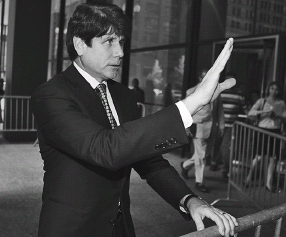
(Getty Images)
(Left) During her weekly news conference in June 2011, House Minority Leader Representative Nancy Pelosi refuses to answer questions about the news that House Representative Anthony Weiner was to resign that day amid a lewd Twitter photograph scandal. (Right) Former Illinois Governor Rod Blagojevich leaves the Dirksen U.S. Courthouse on Tuesday, June 7, 2011, after another day in his retrial on federal corruption charges in Chicago, Illinois.
“Convincing” Steepling Gestures
As the awareness of body language grows, so does the artificial use of certain gestures to communicate power—or a lack of power, as you’ll see in the next section (which I affectionately call “the naughty bit bonanza”). Both the attempt to show power or a lack of power can be used to try to convince us of lies. For instance, when someone genuinely uses a steeple—holding hands in a way so that all fingertips are touching—it communicates power, security, and confidence. But steepling can also appear with liars who are overly confident and trying to nonverbally bully you: “I’ve got it all figured out; I have a plan. Don’t even try to question me.” Donald Trump does it; Oprah does it; even Mr. Burns on The Simpsons does it.
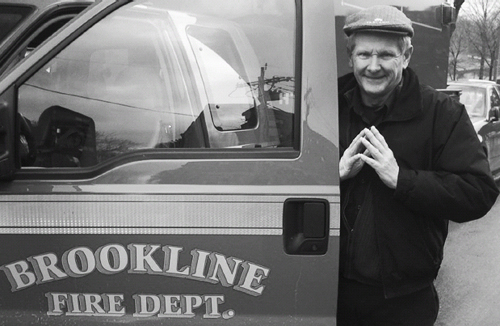
Check out my super-cool and awesome dad, who is a fire department mechanic. He’s making a steepling gesture, a power move, next to his work truck. Once Dad had to testify in court as an expert and he was nervous for nearly a year, so on the big day, while testifying, he brought out the big guns—yup, the steeple—to overcompensate for his nerves. (Janine Driver)
Crotch Displays
In law enforcement, we see a lot of the bad guys’ crotches, or what I’ve nicknamed “naughty bits”—especially when they’re getting defiant. During an interrogation, as we’re getting closer and closer to the truth, convincers will suddenly pull their feet underneath their chair. Or they’ll wrap their feet around the legs of the chair, spread their knees, and do a crotch display. These movements are not a sign that they’re confessing—not even close. We see this when they’re being openly defiant. This sign is like saying, “Screw you—you’re not getting anything from me.”
The openness may also be giving the liars in your life more confidence. Columbia University psychologist Dana Carney says that these open postures stimulate a biochemical response, raising testosterone and lowering cortisol, all in one simple shift of body language.2 When you see this shift, know that the person is feeling more confident—and the position itself will only help that.
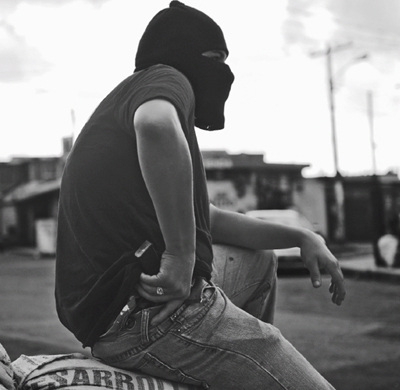
On July 19, 2011, this hooded man holding a gun was demonstrating a confidence crotch display in a neighborhood in the southern outskirts of Guatemala City. He and many other men in hoods were there to prevent an attack from the Mara Salvatrucha gang, who have threatened and extorted members of their community. (Getty Images)
Forward Leans
While liars tend to bring out the big guns, flash their private areas, and lean their upper bodies back, the opposite is usually true of truthful people. They are more likely to bring their groins backward and put their “bits” in lockdown, as they lean the upper body toward people—I want you to believe me, I’m telling the truth. In convince-not-convey, liars might use this pose for the exact same reason—trying to lean forward to impress you with their “genuineness.”
NONVERBAL SIGNALS OF POWER
Power is more than a state of mind—it’s also a nonverbal signal. People associate power with people who:
- Smile less
- Gaze more
- Touch others more
- Gesture more
- Interrupt more often
- Speak in a louder voice
In situations when degrees of power are not immediately known, people will use these nonverbal signals to understand who holds the most power in a room. People who stride across a room, or who move around more often, are seen as having more power because they are perceived by others as having the freedom to determine their own actions.3 Check out the body language of everyone lined up to see Obama—notice how they all make themselves smaller with self-soothing gestures and body blocking.

President Obama talks with Americans involved in Chilean miner rescue. (Associated Press)
Fake Fig Leaves—Keeping the “Bits” in Lockdown
When the fig leaf—holding your hands in front of your naughty bits—is real, it communicates humility, timidity. But when it’s not real, it’s an attempt to manipulate the other person into believing you’re not a threat: I’m way more innocent than you might think, really! Case in point: our very distraught Paris Hilton, with her turned-up eyebrows of true sadness, is now skipping down the path out of jail, very contrite—can’t you just tell?
You would never know she immediately went on Larry King Live and lied about not doing drugs. Keep talking, Paris—that will convince everyone.

Paris Hilton, when she was released from jail after two days. (WireImage)
BACKSLIDING
Now we come to the category that’s among the easiest to spot: backsliding. Whereas convince-not-convey was all about “puffing up” signals, making them more pronounced and in your face, backsliding is exactly the opposite—the suspect is trying to minimize everything about herself: her voice, her movements, even the space she takes up within your vision. She is looking to beat a hasty retreat—but you’re not going to let her because you know how to spot the secrets to backsliding.
The Implosion
Think about when you’re embarrassed and you screw up. Or, when your little kid comes in from doing something they shouldn’t have. They point their right foot in a circle on the ground. Mom, I broke your vase. Their shoulders are up, and they’re not using hand gestures. They want to disappear.
We get small when we get embarrassed. When I do speaking engagements, I start going toward the audience to get volunteers. You can see the people who are deathly afraid or introverted and don’t want to be on stage—just watch their feet. Their feet might be straight in front of them, like underneath the table, and all of a sudden both feet pull underneath the chair, right under their butt. Please don’t pick me.
When you’re norming people for detecting deception, note their stance. If a guy is sitting there with open stance, and then you ask, “Are you in love?,” and he crosses his ankles, he’s getting smaller—that’s backsliding.
If you ask, “Are you married?,” and she suddenly covers her neck dimple with her hand, or does a thinking pose with her hand over her mouth or on her chin to cover neck vulnerability, that’s a hot spot—she could be lying to you. Or maybe she’s telling the truth and there’s another story there.
The implosion is all about retreating into yourself—slouching, giving short answers with little detail, hiding hands in pockets or under sweaters, leaning back. It’s all about retreat.
Body Blockers
Body blockers are little protective shields people use to feel less exposed. They may hold their coats or their briefcases, or put their pocketbooks across their laps, or suddenly cross their arms. It doesn’t mean they are lying, but it does mean there’s a sudden increase in anxiety in the room. (Just check out the crossed arms and facial touches in the picture of President Obama’s elite team of politicians as they officially heard the news that Osama bin Laden was dead.)

President Barack Obama and Vice President Joe Biden, along with members of the national security team, receive an update on the mission against Osama bin Laden in the Situation Room of the White House, May 1, 2011. (Getty Images)
Backsliders will always opt to have a table, a book, a plate, a cup, anything in front of them. That’s why it’s much better to confront the subject when nothing is available to block him. For example, if you’re headed into Starbucks, go for the couch versus the table—you’ll leave him much more exposed.
Women love to cover their chests by folding their arms and literally putting their hands over their breasts. They’ll suddenly pick up their purse from the floor and put it across their lap. And they’ll begin looking for a pen or something and then keep their purse in their lap. They’ll have their coat on the back of the chair, and they’ll put it across their lap instead. The naughty bits are officially in lockdown mode.
Other forms of body blocking include putting hands on the mouth, neck, throat—any of the vulnerable areas where most people feel the truth can leak out. A big one is eye blocking. You’ll see this when people start to squint.
You say, “Janine, I asked you to pick up the groceries at one o’clock.”
“You did? You said one o’clock to pick up the groceries? At one?” And I squint my eyes.
Now, I know damn well you said one o’clock—but I’m trying to block my eyes, to prevent you from seeing the truth.
Eye blocking should be a big red flag when it’s done by people who care for the most vulnerable—your child, your aging parents, your pets. When you pick up your kids at school, does the teacher give everyone eye contact but you? What about the principal? The school bus driver? Maybe they always look away. You go to pick up your kid, and they’re busy putting the backpack on little Johnny while you’re picking up Sara. Always busy so they never look you in the eye. Don’t let it go—walk right up and ask how the day went.
Let all who care for your dependents know that you are a family, you stick together, and you see what’s going on. Leave the cell phone inside, walk your kid to the school bus, look the bus driver in their face, say their name, tell your kid, “I love you. I’ll see you later today.” Let the people who surround your family know you pay attention to everything that’s happening.
NAVEL INTELLIGENCE
In my last book, I spoke a lot about how the belly button rule (a.k.a., “navel intelligence”) shows us that people align their belly buttons with the objects of their interest. So unless someone is incredibly savvy about body language, you can usually tell where they want to be in a conversation. If he started the conversation with his belly button pointed straight at yours, and now his entire body is twisted toward the door, and only his head and neck are turned to you, he is aching to leave—that’s a hot spot.
Pacifiers
Self-touch is often used as an unconscious way to relieve tension. If you’ve ever seen someone bite their nails, twirl their hair, or pick their cuticles, you’ve seen what nonverbal expert Joe Navarro termed “pacifiers” in action. They’re ways that we unconsciously touch our bodies to self-soothe. You may see these in a nervous person, whether she’s a backslider—it’s her way of dialing down the anxiety of the situation.
Some of the most common pacifiers are listed in the table.
Body Part |
Pacifier |
Hands
|
Biting nails |
Cracking knuckles |
|
Examining nails |
|
Folding hands or arms across chest |
|
Hands wrapped up in shirt, scarf |
|
Picking cuticles |
|
Picking “dirt” out from under nails |
|
Rubbing hands together |
|
Stretching/pulling on fingers |
|
Squeezing/pinching skin on top of hands |
|
Tapping fingers |
|
|
Wringing hands |
Mouth
|
Chewing on lips |
Chewing gum |
|
Clearing throat |
|
Coughing |
|
Hand over mouth or on top of lips |
|
Licking lips (dry mouth caused by nerves) |
|
Requesting to smoke |
|
Sighing or yawning (need to get extra oxygen!) |
|
|
Swallowing |
Body
|
Continually crossing and uncrossing legs Picking |
Pinching |
|
Picking lint off clothes |
|
Pulling threads in clothing, nylons, or leggings |
|
cratching |
|
Smoothing skirt, pants |
|
Stroking arm, leg, or throat |
|
|
Suddenly crossing legs at a critical moment |
Ears
|
Digging in ear canal with finger or object |
Playing with cartilage |
|
Pulling or pinching earlobes |
|
|
|
|
|
|
|
Hair
|
Blowing bangs around |
Braiding |
|
Making ponytail, “up-do” |
|
Playing with dead ends Putting ends in mouth (gross, I know!) Smoothing, rubbing, stroking hair Twisting and twirling |
|
Face
|
Hand covering part of face or eyes |
Picking zits |
|
Scratching |
|
Tearing up (genuine or feigned) Wiping forehead (trying to hide sweat) |
|
Feet
|
Behind chair legs |
Jiggling |
|
Swinging legs |
|
Tucked up under bottom (all photos: Baron Thrower II) |
We all do some of these sometimes. But if someone has been exhibiting confident open body language and then suddenly starts pacifying with one or more of these signals, that’s a massive hot spot!
THE FINAL TAKING CARE OF BUSINESS REMINDER: JUST SAY NO TO MIND READING!
I hope by now you know that mind reading is an approach that is destined to trash a lot of your relationships. You simply cannot point to any one body movement or gesture or verbal tic and say, “That’s it!” Trust me—hundreds of experts spend millions of dollars a year looking for that Pinocchio sign. It simply doesn’t exist.
Mind reading is a surefire recipe for destruction—you can destroy profits, possibilities, even people! Just say no!
Now that you have a good handle on the New Body Language cues that can indicate hot spots, you can use all those little signs—crossed ankles, crossed arms, hands over the neck, men playing with their collars because it’s getting hot under there, legs wrapped around chair legs—as a series of hot spots to dig into. In the next chapter, we’ll start to put the screws to them in step 5: “The Interrogation.”
EXERCISING YOUR BS BAROMETER: FULL BODY SURVEILLANCE
Full body surveillance is some of the easiest homework to do on the fly. Any time you are in line at the bank or the grocery store, you can be exercising your BS Barometer.
Tube In!
Again, visit www.youtube.com/user/bsbarometer and watch one person’s baseline video first, then the two corresponding stories next. You’ve learned a tremendous amount about liars’ conscious and unconscious signals of deception. You know those telltale hot spots can show up anywhere on a person’s face, body, or in their voice. Can you spot which one of the videos contains the lie based on comparing the person’s verbals to their nonverbals? Once you’ve completed your assessment and made your guess, then click on my video analysis to reveal the truth about that person.
POWER TEAM TURNAROUND

(Baron Thrower II)
Name: Eugene Smith
Age: 35
Occupation: Magazine publisher
What was stopping you from spotting master manipulators and liars?
Prior to the DDPT [Detecting Deception Power Team] program I was only partially aware of how manipulators and liars do what they do. I believe that I would turn a blind eye to people whom I got a “bad vibe” from. Sometimes I would feel as though I was slighting them, and I would allow them partial entry to my life.
How have you changed?
This course has helped me to become more self-aware, and conscious of my body language and intentions. Now I know to ask powerful questions that will create clarity, and allow the other person to feel uncomfortable instead of me. I have discovered that most of my relationships are ultimately in my control, especially once I can truly accept the worst-possible-case scenario.
The most valuable lesson I’m taking away is how disruptive deception really is. Deception is exhausting for both the deceivers and the people who know that they’re being deceived. No one is able to keep up a lie without using energy, and that use of energy shows on their face and in their body language. The search for the truth can be exhausting—but as the truth is found, energy is returned to the seeker and stripped from the deceiver!
I was deceived in the past mainly due to not providing the proper degree of consequences. I now protect myself as a CEO. I monitor my body language, and I challenge myself to always ask powerful questions. This makes my employees even more responsive, intuitive, and more likely to follow directions.
Keep Your Skills Sharp Like the Experts
Even expert private investigators need practice to keep up their skills. Marti, my private investigator friend, makes it a game. Whenever she’s sitting in a restaurant, waiting in line at the grocery store, or people-watching in a park, she’ll keep an eye out for people’s body language. “I’ll watch when a guy walks up to a woman in a restaurant or bar, and I’ll watch and see if she’s twirling her hair,” says Marti. “Let’s see how interested she really is in him.” She’ll watch their belly buttons, see if their shoulders are shrugging, if their naughty bits are out, the angles of their heads, the changes in posture—everything. Try it out during your next interminable wait at the post office or in the doctor’s waiting room.
Give Your Visual Information Channel a Checkup
When in a new situation, or when you start to get a twinge of suspicion about an old one, do you attempt to get your bearings? Do you take a quick peek around you to assess any immediate dangers? Is there anything you see that should warrant concern? Or is there a glaring hot spot front and center that you are missing every time?
To fine-tune your attention to details, spot the seven differences between the set of pictures of my parents, two sisters, and me on the Royal Yacht, the Queen’s Ship Britannia in Edinburgh, Scotland.

(Janine Driver)

(Janine Driver)
Did you spot all seven differences? No?! That’s because there were only six!
When you failed to find number six, what happened? Did you give up quickly? Were you irritated and frustrated? Or did you cheat and look at the answer section? (C’mon, just admit it! Don’t lie to yourself!)

(Janine Driver)
Next time, use this technique. Take a sheet of paper and cover 90 percent of both pictures with the paper. Now, work your way down slowly, and you might spot the differences sooner. The same holds true when using your BS Barometer: visually compartmentalize the target’s body into small sections; now work from the head … to the shoulders … to the knees … to the toes. You might be surprised what you find out!
Follow My Fingers with Your Eyes
Time to put your visual memory to the test! Set the timer on your oven, microwave, or your smartphone for forty-five seconds. Once the clock is ticking, observe the picture below and absorb as many details as possible. Once the timer goes off, turn the page and answer the questions.
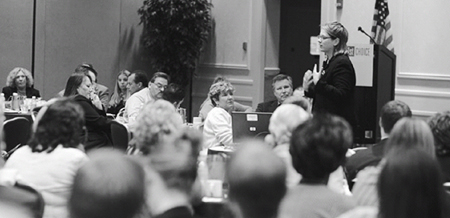
Janine Driver gives her keynote speech on how to use body language to increase sales by more than 25 percent within the first month to a sales force of a leading real estate company. (Janine Driver)
Questions
- Where is the EXIT sign in this picture?
- What am I (yes, that stunning creature is Yours Truly!) doing with my hands?
- What is the object on the wall directly above my head?
- How many doors are in the picture?
- Approximately how many people are in the picture (including me)?
- Which hand am I holding the microphone in?
Answers
- Far left.
- They’re up in front of me, with palms cupped open.
- The light that goes off when there is a fire alarm.
- Two.
- Twenty-six.
- Trick question, there is no handheld mic!
- What did you learn from this visual memory exercise?
- Did you make up an answer when you were unsure? You do realize that this sets you up to be perceived as a liar or as someone who will do anything to avoid failure?
- If you were to do this exercise again, what would you do differently? Why?
- How will what you learned from this exercise empower you as a lie catcher?
Flip the Digits
This exercise trains your brain’s memory, language, and executive functions.
Step 1. Read the following numbers out loud: 7–2–1–9–4.
Step 2. Say them again, but put the book down (and no peeking).
Step 3. Turn to the next page for your next task.
Step 4. Say the numbers I gave you out loud, but do it backward. Write the numbers down on a piece of paper with the last number first and the first number last.
Step 5. Now that you’ve practiced, repeat the steps with the following number combinations (and score yourself):
4 4 9 2 1 7 |
6 7 4 3 9 2 |
4 3 5 8 1 9 |
6 4 7 2 9 3 |
2 1 7 5 3 6 |
7 2 3 1 4 3 |
4 8 7 7 6 1 |
9 9 8 2 5 1 |
2 3 6 7 9 5 |
1 7 6 2 9 8 |
8 9 8 9 2 7 |
7 8 9 2 7 1 |
How long does it take you to recall the numbers backward? How many numbers can you recall? All six numbers would show superior intelligence!
This exercise is important when you are listening to different chunks of a person’s story. During the first interview, when the prospective employee told you about his work history with a specific company, didn’t he say he interned there for six months, then worked there for one year? But the second time he told the story two days later, he said he interned for a year, then worked for six months? Which one is correct?
The truth can be found in the details, and if you aren’t able to chunk information in your head from the beginning to the end, and from the end to the beginning, your job candidate might just be able to pull the wool over your eyes more often than you think!
Quick tip: think like a movie director and create an internal vision board as your frame of reference.
JUST REMEMBER …
- Stay open. Using confident, relaxed body language will keep your target feeling less stressed and more likely to share the truth.
- Pacifiers don’t indicate guilt. They merely indicate anxiety. Some people’s norm is to be a bundle of nerves. Crossed arms or wringing hands might just mean they’re cold!
- Watch that crotch! When you see a guy lean back and spread his legs during a tense conversation, be prepared—he might be gearing up for a counterattack.
